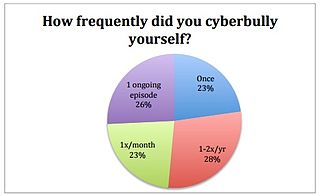Related Research Articles
An online community, also called an internet community or web community, is a community whose members interact with each other primarily via the Internet. Members of the community usually share common interests. For many, online communities may feel like home, consisting of a "family of invisible friends". Additionally, these "friends" can be connected through gaming communities and gaming companies. Those who wish to be a part of an online community usually have to become a member via a specific site and thereby gain access to specific content or links.

Bullying is the use of force, coercion, hurtful teasing or threat, to abuse, aggressively dominate or intimidate. The behavior is often repeated and habitual. One essential prerequisite is the perception of an imbalance of physical or social power. This imbalance distinguishes bullying from conflict. Bullying is a subcategory of aggressive behavior characterized by hostile intent, imbalance of power and repetition over a period of time.

Suicidal ideation, or suicidal thoughts, is the thought process of having ideas, or ruminations about the possibility of ending one's own life. It is not a diagnosis but is a symptom of some mental disorders, use of certain psychoactive drugs, and can also occur in response to adverse life events without the presence of a mental disorder.
Workplace bullying is a persistent pattern of mistreatment from others in the workplace that causes either physical or emotional harm. It can include such tactics as verbal, nonverbal, psychological, and physical abuse, as well as humiliation. This type of workplace aggression is particularly difficult because, unlike the typical school bully, workplace bullies often operate within the established rules and policies of their organization and their society. In the majority of cases, bullying in the workplace is reported as having been done by someone who has authority over the victim. However, bullies can also be peers, and subordinates. When subordinates participate in bullying this phenomenon is known as upwards bullying .The least visible segment of workplace bullying involves upwards bullying where bully- ing tactics are manipulated and applied against “the boss,” usually for strategically designed outcomes.
Social learning is learning that takes place at a wider scale than individual or group learning, up to a societal scale, through social interaction between peers.
Internet safety, also known as online safety, cyber safety and electronic safety (e-safety), refers to the policies, practices and processes that reduce the harms to people that are enabled by the (mis)use of information technology.

School bullying, like bullying outside the school context, refers to one or more perpetrators who have greater physical strength or more social power than their victim and who repeatedly act aggressively toward their victim. Bullying can be verbal or physical. Bullying, with its ongoing character, is distinct from one-off types of peer conflict. Different types of school bullying include ongoing physical, emotional, and/or verbal aggression. Cyberbullying and sexual bullying are also types of bullying. Bullying even exists in higher education. There are warning signs that suggest that a child is being bullied, a child is acting as a bully, or a child has witnessed bullying at school.
Attention seeking behavior is to act in a way that is likely to elicit attention. Attention seeking behavior is defined in the DSM-5 as "engaging in behavior designed to attract notice and to make oneself the focus of others' attention and admiration". This definition does not ascribe a motivation to the behavior and assumes a human actor, although the term "attention seeking" sometimes also assumes a motive of seeking validation. People are thought to engage in both positive and negative attention seeking behavior independent of the actual benefit or harm to health. In line with much research and a dynamic self-regulatory processing model of narcissism, motivations for attention seeking are considered to be driven by self-consciousness and thus an externalization of personality rather than internal and self-motivated behavior. Attention seeking is often caused by threats to one's self-concept and the need for social acceptance. This type of influence on behavior can result in a potential loss of a person's sense of agency, personality disorder and the behavior associated with these conditions.
Researchers study Social media and suicide to find if a correlation exists between the two. Some research has shown that there may be a correlation.

Sexual bullying is a form of bullying or harassment in connection with a person's sex, body, sexual orientation or with sexual activity. It can be physical, verbal or emotional in nature, and occurs in various settings, including schools, workplaces, and online platforms. Sexual bullying can have serious and lasting effects on the mental and emotional well-being of victims.
Bullying and suicide are considered together when the cause of suicide is attributable to the victim having been bullied, either in person or via social media. Writers Neil Marr and Tim Field wrote about it in their 2001 book Bullycide: Death at Playtime.

Experts from many different fields have conducted research and held debates about how using social media affects mental health. Research suggests that mental health issues arising from social media use affect women more than men and vary according to the particular social media platform used, although it does affect every age and gender demographic in different ways. Psychological or behavioral dependence on social media platforms can result in significant negative functions in individuals' daily lives. Studies show there are several negative effects that social media can have on individuals' mental health and overall well-being. While researchers have attempted to examine why and how social media is problematic, they still struggle to develop evidence-based recommendations on how they would go about offering potential solutions to this issue. Because social media is constantly evolving, researchers also struggle with whether the disorder of problematic social media use would be considered a separate clinical entity or a manifestation of underlying psychiatric disorders. These disorders can be diagnosed when an individual engages in online content/conversations rather than pursuing other interests that occur in real life.
Cyberbullying or cyberharassment is a form of bullying or harassment using electronic means. Cyberbullying and cyberharassment are also known as online bullying. It has become increasingly common, especially among teenagers and adolescents, due to the communication technology advancements and young people's increased use of such technologies. Cyberbullying is when someone, typically a teenager, bullies or harasses others on the internet and other digital spaces, particularly on social media sites.

Amanda Michelle Todd was a 15-year-old Canadian student and victim of cyberbullying who hanged herself at her home in Port Coquitlam, British Columbia. A month before her death, Todd posted a video on YouTube in which she used a series of flashcards to tell her experience of being blackmailed into exposing her breasts via webcam, and of being bullied and physically assaulted. The video went viral after her death, resulting in international media attention. The original video has had more than 15 million views as of May 2023, although mirrored copies of the video had received tens of millions of additional views shortly after her death; additionally, a YouTube video by React has a video of teens reacting to Todd’s video which has garnered 44.7 million views as of May 2023, and various videos from news agencies around the world regarding the case have registered countless millions more. The Royal Canadian Mounted Police and British Columbia Coroners Service launched investigations into the suicide.

Confessions pages are pages on social networking websites, or stand alone website pages which are generally used at schools and universities for students to anonymously post their confessions and secrets to their respective communities. Confessions, statements acknowledging personal facts that someone would prefer to not be shared under their true identity, are sent to the administrators of the page through online form services such as SurveyMonkey and Google Forms or submission portals created with purpose-built tools. The administrators then decide which confessions to post on the page.

Rehtaeh Anne Parsons, was a 17-year-old Cole Harbour District High School student who attempted suicide by hanging at her home in Dartmouth, Nova Scotia, Canada, on April 4, 2013, leading to a coma and the decision to switch her life support machine off on April 7, 2013. Her death has been attributed to online distribution of photos of an alleged gang rape that occurred 17 months prior to her suicide, in November 2011. On a Facebook page set up in tribute to her daughter, Parsons' mother blamed the four boys who allegedly raped and released images of her, the subsequent constant "bullying and messaging and harassment", and the failure of the Canadian justice system, for her daughter's decision to die by suicide.
Bullying in higher education refers to the bullying of students as well as faculty and staff taking place at institutions of higher education such as colleges and universities. It is believed to be common although it has not received as much attention from researchers as bullying in some other contexts. This article focuses on bullying of students; see Bullying in academia regarding faculty and staff.
Online child abuse is a unique form of child abuse also known as “Cyber Molestation” due to its virtual, distanced, and anonymous nature. Such abuse may not happen face-to-face, nor does it necessarily require physical contact. However, online abuse can result in negative face-to-face consequences in the form of statutory rape, forcible sexual assault, harassment, etc. In the United States, online child abuse is recognized as a form of child abuse by the National Society for the Prevention of Cruelty to Children.

Auto-trolling, self-cyberbullying, digital Munchausen or digital self-harm is a form of self-abuse on the Internet. It is usually done by teenagers posting fake insults on social media, attacking themselves to elicit attention and sympathy. A study in 2012 found that about 35 per cent of those who did this felt better. Studies in 2016 and 2019 found an increase in prevalence in American adolescents rising from 6 to 9 per cent. In a 2011 study, boys were more likely than girls to admit to digital self-bullying. In a 2022 study published by researchers Justin Patchin, Sameer Hinduja, and Ryan Meldrum, US youth who engaged in digital self-harm were between five and seven times more likely to have considered suicide and between nine and fifteen times more likely to have attempted suicide.
References
- ↑ Coughlan, Sean (October 1, 2019). "'Sadfishing' warning on social media". BBC News.
- ↑ Boyd, Milo; Gibbons, Brett (October 1, 2019). "Kendall Jenner-inspired 'sadfishing' trend 'puts children at risk of grooming'" – via www.mirror.co.uk.
- ↑ Bernal, Natasha (October 1, 2019). "Sadfishing: The toxic social media trend that could be harming your child". The Telegraph– via www.telegraph.co.uk.
- ↑ correspondent, Sally Weale Education (September 30, 2019). "Young people who seek support online being accused of 'sadfishing'". The Guardian– via www.theguardian.com.
- ↑ Mahmood, Basit (October 1, 2019). "'Sadfishing' is playing into hands of paedophiles and bullies" – via www.metro.co.uk.
- ↑ Staloch, Laura (2022-12-02). "Psychologists have started to examine why people engage in "sad-fishing" on the internet". PsyPost. Retrieved 2023-12-24.
- ↑ Dorking, Marie (October 1, 2019). "Social media 'sadfishing' trend found to be harming mental health of children, but what is it?" – via www.msn.com.
- ↑ Fischer, Kristen (October 10, 2019). "Sadfishing 101: How to Tell if Your Friend's Social Media Post Is a Plea for Attention—or a Cry for Help" – via www.parade.com.